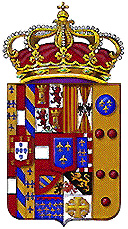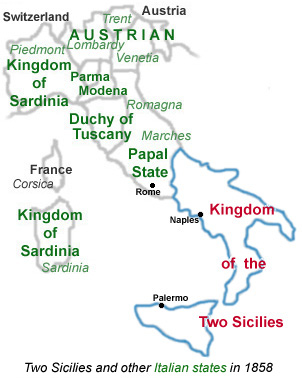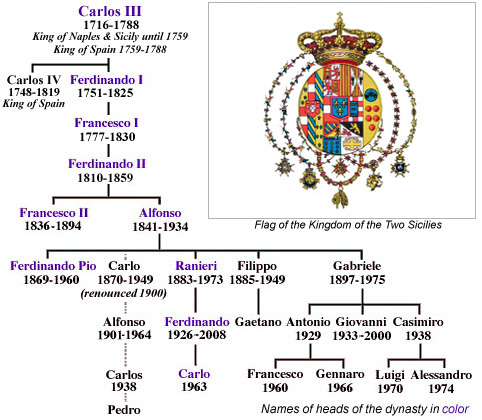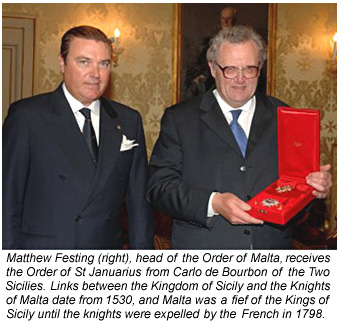...Best of Sicily presents... Best of Sicily Magazine. ... Dedicated to Sicilian art, culture, history, people, places and all things Sicilian. |
by Luigi Mendola | ||
Magazine Index Best of Sicily Arts & Culture Fashion Food & Wine History & Society About Us Travel Faqs Contact Map of Sicily
|
Leaving aside the genealogical complexities, we can say that in 1282 the War of the Vespers brought Sicily into the Aragonese and then Spanish orbits. The early decades of the eighteenth century saw the kingdom founded in 1130 by Roger II ruled briefly by Savoys and Austrian Hapsburgs. In 1731, Charles (Carlos) de Bourbon, a younger son of King Philip V of Spain (the monarch who had ruled Sicily until 1713), landed in Italy and soon claimed the crown of Parma inherited through his mother, Elisabeth Farnese. It appeared that the young prince might not succeed his father as King of Spain because that right appertained to Philip's elder son by an earlier wife, so the tiny but flourishing Duchy of Parma would have to suffice. Before long, the ambitious Charles and his army swept through the southern part of the Italian peninsula and then to Sicily, wresting the island kingdom from Austrian control. He was crowned King of Sicily in Palermo Cathedral in 1735. Establishing himself at Naples, the young monarch was the first king to actually live in the "Two Sicilies" in centuries. Charles ceded Parma to a younger brother. Though the kingdoms of Naples and Sicily were not unified (to form the Two Sicilies) until 1816, they had sometimes been ruled by the same kings over the centuries, usually from afar. The name Two Sicilies dates from the Vespers, when two kings - in Naples Charles Anjou (the less-than-saintly brother of Saint Louis) and in Sicily Peter of Aragon - claimed the Sicilian crown, the former by right of conquest supported by the Pope, the latter by his queen's right of inheritance from Frederick II and support from the Sicilian barons.
In 1759 Charles succeeded his elder half-brother, Ferdinand, as King of Spain. Taking his own older son Carlo (later Carlos IV of Spain) with him, he left young Ferdinando as King of Naples and Sicily, establishing that the Spanish and Neapolitan-Sicilian crowns were to be forever separate and distinct. In other words, no single sovereign could succeed to both thrones. Unlike Vittorio Amedeo of Savoy, who raided the treasury before leaving Sicily in 1720, Charles took no monetary assets with him to Spain. Charles' immediate heirs never approached his intellectual stature, but Ferdinando I was at least competent if occasionally cynical. Seeking refuge in Palermo during uprisings and then the French occupation of Naples, he eventually granted a Constitution to the Sicilians in 1812. In the process he abolished feudalism and established a peerage and parliament loosely based on the model of the British whose troops were then preparing Sicily against a possible Napoleonic invasion. His first wife, the mother of his children, was the popular Marie Caroline Hapsburg of Austria, who is still remembered in the annals of the history of the Palermitan aristocracy. Unfortunately, in 1798 Ferdinando lost Malta, a Sicilian fief and protectorate since the eleventh century, to the French, who expelled the Knights of Saint John. The islands of Malta and Gozo were subsequently occupied by the British. Ferdinando's grandson, the future Ferdinando II, was born in Palermo in 1810. He was, in fact, the first monarch born on Sicilian soil in centuries, and he was to be the last. Upon returning to Naples, Ferdinando promptly rescinded the Constitution and united the Sicilian and Neapolitan realms under one crown. He thus broke several promises, prompting dissension by malcontents over the next few decades. This was especially unfortunate because Sicily's British-influenced Constitution of 1812 was far ahead of its time in its guarantees of fundamental rights; nothing like it would be formulated in Italy for another 36 years. His son, Francesco I, who succeeded in 1825 was a proven administrator, having occasionally served as the king's de facto representative, or alter ego, in Sicily. He wed, firstly, Clementine Hapsburg of Austria, but his heir was a child of his second wife (and cousin), Marie Elisabeth of Spain. Francesco died in 1830 and was succeeded by the Palermo-born Ferdinando II. Ferdinando II seems to have been a born bureaucrat, but at least he was a shrewd one. He sponsored various agricultural projects which were at the cutting edge for their time. In 1832, he ordered the first differentiated refuse collection in what is now Italy, with a focus on recycling glass. In 1839, he sponsored construction of the first railroad in Italy, from Naples to his palace at Portici, and the network was soon extended along the coast and inland. (Piedmont had more track by 1860 because in the Two Sicilies - a peninsula and large island - transport by sea was often more convenient and economical than by land, and therefore developed further.) This efficiency extended to politics. Ferdinando adroitly but ruthlessly put down the revolts of 1848, which began in Palermo and spread across Europe. On balance, he was no better or worse than his contemporaries, and probably more intelligent than many. Yet for his authoritarian rule he was widely criticized, especially in Britain. Like his father, he spoke Neapolitan as his mother tongue. His first wife, mother of his heir Francesco, was Maria Cristina of Savoy, who died young but was venerated as a saint almost immediately. Her kin, the King of Sardinia (who ruled from Turin in Piedmont), wanted to unite Italy and effectively offered the hypothetical crown to Ferdinando, who refused out of loyalty to the Pope - at that time the zealous Pius IX. It would have been impossible to unite the Italian territories without annexing the Papal States in the middle of the peninsula. Moreover, unificationists considered Rome the "natural" capital of a united Italy. Nobody in Italy dared challenge Ferdinando II militarily. He commanded the largest army and navy in the Italian states, and had shown his willingness in using it when necessary. The country's resources in arms manufacture were formidable, while the sulphur mines in Sicily and Basilicata provided for a seemingly infinite supply of gunpowder. (Sadly, directives to prevent children from working as miners were rarely obeyed.) Moreover, Naples' gold reserves eclipsed those of all the other Italian states combined. When Ferdinando died, very prematurely, in 1859, he was succeeded by Francesco II, the pious "son of the saint." That Francesco was half Savoy did not discourage the machinations of Vittorio Emanuele II and his minions, who included the competent Cavour and the wily bigamist Crispi. The Savoy camp made Francis a proposal similar to the one presented to his father to rule a united Italy, possibly as part of a federation including the Papal territories which would be confiscated from Pope Pius IX. Like his father, Francis refused. Francesco failed to take action when Garibaldi disembarked in western Sicily in 1860, and the following year the peninsular part of the kingdom fell to invading forces sent from Piedmont. Maria Sophia of Bavaria, Francesco's wife, Sicily's last queen, lived until 1925 and was fondly remembered. Francesco had no sons; the Bourbons living today descend from Marie Therese Hapsburg of Austria, second wife of Ferdinando II. Its kings may not have all been exceptional but the kingdom certainly was, despite later propaganda that painted it as "backward." Here are some milestones and figures regarding Italy's most prosperous state just before controversial unification in 1860. First, the gold reserves (plus circulating currency) of the pre-unitary states' central (national) banks, based on "gold lire" in millions but valid as a measure of proportional value: • Two Sicilies - 443.2 For comparison, it is estimated that the former territory of the Kingdom of the Two Sicilies, with a population of some 7 million, had around 3,216 students enrolled in its public universities immediately after unification (1863/64 academic year), almost half the Italian national total (excluding the city of Rome) of 7,957. Piedmont-Sardinia alone had a population of 4.2 million, and far fewer university students per capita. Incidentally, Piedmont had a much higher national debt at over a billion lire compared to 411 million for the Two Sicilies. A particular myth about the people of the Kingdom of the Two Sicilies and their wealth compared to that of other Italians is easily dispelled: The Landless Peasant. Despite the presence of large estates (latifondi) held by the nobility into the twentieth century, especially in grain-growing areas, most Sicilians of the eighteenth and nineteenth centuries owned their own homes and at least a garden or small parcel of land. The ready proof of this are the land tax records or riveli retained at Palermo's state archive. Those of 1748 and 1811 list numerous smallholders in each Sicilian town. A few achievements in the Kingdom of the Two Sicilies relative to the other Italian states, particularly during the nineteenth century: • First pension system in what became Italy (2% deduction from salaries)
Garibaldi's invasion resulted in terrible atrocities – actually reprisals – of a kind unknown in Sicily in centuries, particularly in the Etna region where Nino Bixio's troops massacred numerous, unarmed civilians in the town of Bronte (see Riall's well-researched book mentioned below). This kind of thing did not end in 1860. Until 1866, a series of protests and riots (particularly in Palermo) demanded the return of King Francis II. By then, Piedmontese troops occupied Sicily to suppress these movements and any other dissent. Throughout the south, thousands of "rebels" and "brigands" of the resistance movement, mostly ex-soldiers of the Two Sicilies, were sent to die in "secret" northern prisons such as Fenestrelle (a large fort in the Alps) similar to concentration camps, and thousands more were sentenced to death and executed; in 1869 the Italian (Piedmontese) government sought to purchase an Argentine island to house these prisoners, thereby eradicating any chance of their story making its way into the popular mind. Apart from the post-war resistance, numerous officers of the Two Sicilies were imprisoned and killed by the Piedmontese in 1861 as a matter of course. Naturally, the press was censored more than ever, regarding Fenestrelle and everything else. The monastic schools which constituted an important part of the educational system were closed as church-owned land was confiscated, yet in Sicily few public schools were established to fill this void until the twentieth century. (As a result, whereas in 1860 illiteracy throughout Italy was about equal from north to south, it became comparatively worse in Sicily after 1861.) In the wake of the fall of the Two Sicilies, the region was abandoned but exploited. Taxes were increased, and so was military conscription, with a disproportionate number of southerners serving in Italy's twentieth-century wars. By 1900, industry was being developed in Milan and Turin rather than in Naples or Palermo, where the level of organized crime increased. Serious land reform breaking up the large hereditary estates did not arrive in Sicily until 1948, after the Savoys had left. What occurred in Italy from 1861 until 1945 was a classic, text-book example of how not to run a country, and the effects are still with us - throughout Italy - to this day. In the "Two Speed Europe" Italy finds itself on a tier with Spain and Greece rather than Germany, Britain and France, and for decades has received European Union subsidies to aid economic development. A particularly striking effect is Italians' lack of nationalism or a sense of unity as a people. One of the myriad reasons for this is the mediocre "Modern Italian History" taught in schools, so while most Italians are blissfully ignorant of the facts of the Risorgimento (unification movement), they are equally ignorant of the fact that in 1947 their nation was the first to acknowledge having committed both war crimes and crimes against humanity (by its treaty with Ethiopia). Closer to everyday life, the economic divario between North and South is very real. There used to be two Sicilies, but now there are two Italies. The Bourbon kings' reigns were: • 1734-1759 Charles V of Sicily (later Charles III of Spain), son of Philip V of Spain • 1759-1825 Ferdinand III of Sicily (from 1816 Ferdinand I of the Two Sicilies), son of Charles • 1825-1830 Francis I of the Two Sicilies, son of Ferdinand I, above • 1830-1859 Ferdinand II of the Two Sicilies, son of Francis I, above • 1859-1861 Francis II of the Two Sicilies (died in exile 1894), son of Ferdinand II.
Like the House of Savoy and many other non-reigning royal families, the House of the Two Sicilies finds its headship contested - in this case by one of Carlo's cousins who is a member of the Royal House of Spain. That arcane matter need not concern us here except to note that it encourages social-climbing sycophants to seek "vicarious identification" by obsessively defending "their" prince in a bitter "dynastic dispute" that matters little to anybody outside a particular Italian family. On a more edifying note, the dynasty's Constantinian Order of Saint George, an order of knighthood linked to the Catholic Church, supports various charitable works in Sicily and throughout Italy. Tourists may visit two of the family's historic residences, the Chinese Palace in Palermo (in the lush royal park known as the "Favorita") and the Ficuzza hunting lodge in a forest in the Sicanian Mountains, both built around 1800 when Ferdinando I and his family were in Sicily. They are lasting testaments to the dynasty's presence. Closer to Naples, the Bourbons' country estate at Caserta is Italy's most splendid royal palace, today nicknamed "the Italian Versailles." Other palaces are in Naples, Portici and Capodimonte. The multilingual website of the Royal House of Bourbon of the Two Sicilies presents additional historical information about the Two Sicilies dynasty. Further Reading: About the Author: Luigi Mendola has written for various publications. This piece uses (with permission) excerpted material by Vincenzo Salerno and André Mantegna. The gold deposit statistics cited were first published in Francesco Saverio Nitti's Scienze delle Finanze in 1903 and have subsequently been confirmed by other economists, for example by Anteo d'Angio in La Situazione Finanziaria Italiana dal 1796 al 1870 in 1973. See also Nicola Zitara's L'Unita d'Italia - Nascita di una colonia (1971). Numerous books and studies have been published in Italy in recent decades detailing the history of the nation after 1860, many addressing topics censored until 1945. | |
Top of Page |

 Until
the unification of Italy in 1861, it was the largest, most prosperous, wealthiest and populous of the Italian
states. Nearly half of the world's Italians - in Italy and its
Until
the unification of Italy in 1861, it was the largest, most prosperous, wealthiest and populous of the Italian
states. Nearly half of the world's Italians - in Italy and its  An enlightened
monarch, Charles de Bourbon did much to develop his kingdoms. Under him Naples became the wealthiest
city in the Italian states and an important metropolis, boasting Europe's
highest population after London and Paris. Ambitious building programmes resulted
in grand palaces and led to industry advanced for its time in fields such as
metalworks, and glass and porcelain production. (A list of a few of
An enlightened
monarch, Charles de Bourbon did much to develop his kingdoms. Under him Naples became the wealthiest
city in the Italian states and an important metropolis, boasting Europe's
highest population after London and Paris. Ambitious building programmes resulted
in grand palaces and led to industry advanced for its time in fields such as
metalworks, and glass and porcelain production. (A list of a few of  The aftermath of the fall of the Two Sicilies is too significant to avoid mentioning.
A certain degree of
The aftermath of the fall of the Two Sicilies is too significant to avoid mentioning.
A certain degree of 